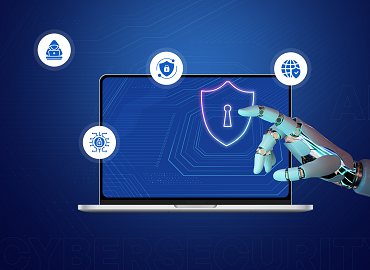
AI-Powered Cybersecurity: Harnessing AI for cyber defence and digital protection
By Anand Jethalia
As cyber threats grow in sophistication, AI is crucial in enhancing cybersecurity. By analysing vast datasets and detecting anomalies, AI improves threat detection, response, and prediction. Adopting AI, along with a unified security view and zero-trust architecture, strengthens defences and ensures proactive protection against evolving cyber risks
As cyber threats continue to evolve, so too must our defences, and AI stands at the forefront of this ongoing effort.
In the digital age, cyber threats have evolved at a pace that can outstrip the best efforts of traditional cybersecurity measures. As businesses and individuals become increasingly reliant on digital technologies, the landscape of cyber threats has grown both in complexity and frequency. Modern cybercriminals leverage sophisticated techniques to breach systems, steal data, and disrupt services. This ever-evolving threat landscape makes it imperative for organisations to adopt advanced cybersecurity measures. Among the most promising of these measures is the incorporation of AI into cybersecurity protocols.
According to a report by Cybersecurity Ventures, global cybercrime costs are expected to reach $10.5 trillion annually by 2025. This exponential growth is indicative of the increasing sophistication of these threats. One of the factors contributing to this sophistication is the use of automated tools and AI by cybercriminals. These tools can scan for vulnerabilities, automate attacks, and even adapt in real time to evade detection.
Staying ahead with AI
Given the advanced nature of modern cyber threats, AI’s role in cybersecurity has become indispensable. AI technologies, including machine learning (ML) and deep learning, can analyse vast amounts of data more quickly and accurately than human analysts. This capability is crucial for identifying patterns and anomalies that may indicate a cyberattack.
One of the primary ways AI enhances cybersecurity is through improved threat detection and response. Traditional methods often rely on known threat signatures, which can be inadequate against new or evolving threats. AI, on the other hand, can learn from vast datasets, identifying unusual patterns of behaviour that may signify an attack. For example, an AI system can detect a sudden spike in network traffic or an unusual login attempt and flag it for further investigation.
AI can also predict potential threats before they occur. By analysing historical data and identifying trends, AI systems can forecast where and how future attacks might happen. This predictive capability allows organisations to fortify their defences preemptively, rather than reacting to attacks after they occur.
Threat hunting involves actively searching for signs of malicious activity within a network. AI can automate this process, continuously scanning for indicators that security may have been compromised and freeing up human analysts to focus on more complex tasks. AI also excels at behavioural analytics, detecting any risky sign-ins and activity outside of the norm.
The Criticality of a Single, Unified View
In this complex landscape, having a single, unified view of security across all systems and devices is critical. This holistic approach enables security professionals to monitor, detect, and respond to threats more efficiently and effectively. A unified security view integrates data from various sources, such as network traffic, endpoints, and user activities, providing comprehensive visibility into the security posture of an organisation.
One of the significant advantages of a unified security view is that it helps to break down silos within an organisation. Security teams can correlate data from different systems, uncovering patterns and anomalies that might go unnoticed when data is analysed in isolation. This integration is essential for identifying sophisticated threats that often span multiple domains and systems.
Maximising Productivity to Secure the Organisation
AI-powered security copilots play a crucial role in streamlining the efforts of security professionals. It acts as an intelligent assistant, automating routine tasks, and providing actionable insights. Integrating a Copilot for Security into an organisation’s cybersecurity strategy not only enhances the efficiency of security professionals but also improves the overall security posture.
This is especially relevant given the shortage of skilled cybersecurity professionals. According to Cybersecurity Ventures, there will be 3.5 million unfilled jobs in the cybersecurity industry through 2025.
The intelligent insights and automation capabilities provided by a copilot enable security teams to focus on more strategic tasks, ultimately strengthening the organisation’s defences against evolving cyber threats.
Zero Trust Approach
One of the most effective cybersecurity strategies in today’s threat landscape is the implementation of a zero-trust architecture. Zero-trust is based on the principle of “never trust, always verify.” This means that no entity, whether inside or outside the network, is trusted by default. Instead, every access request must be authenticated, authorised, and continuously validated.
Zero-trust architecture involves several key components such as Identity and Access Management (IAM), Multi-Factor Authentication (MFA), and continuous monitoring of network traffic and user activity to detect and respond to threats in real-time.
Some other hygiene best practices that organisations should adopt to bolster their cybersecurity posture are regular patching and updates, security awareness training for employees across the organisation, and incident response planning to respond swiftly and effectively to any cyber incidents.
By embracing AI and implementing strategies like zero-trust, organisations can better protect their digital assets and ensure their long-term security. As cyber threats continue to evolve, so too must our defences, and AI stands at the forefront of this ongoing effort.
https://www.moneycontrol.com/news/opinion/ai-powered-cybersecurity-harnessing-ai-for-cyber-defence-and-digital-protection-12858408.htmla>
